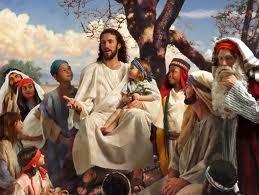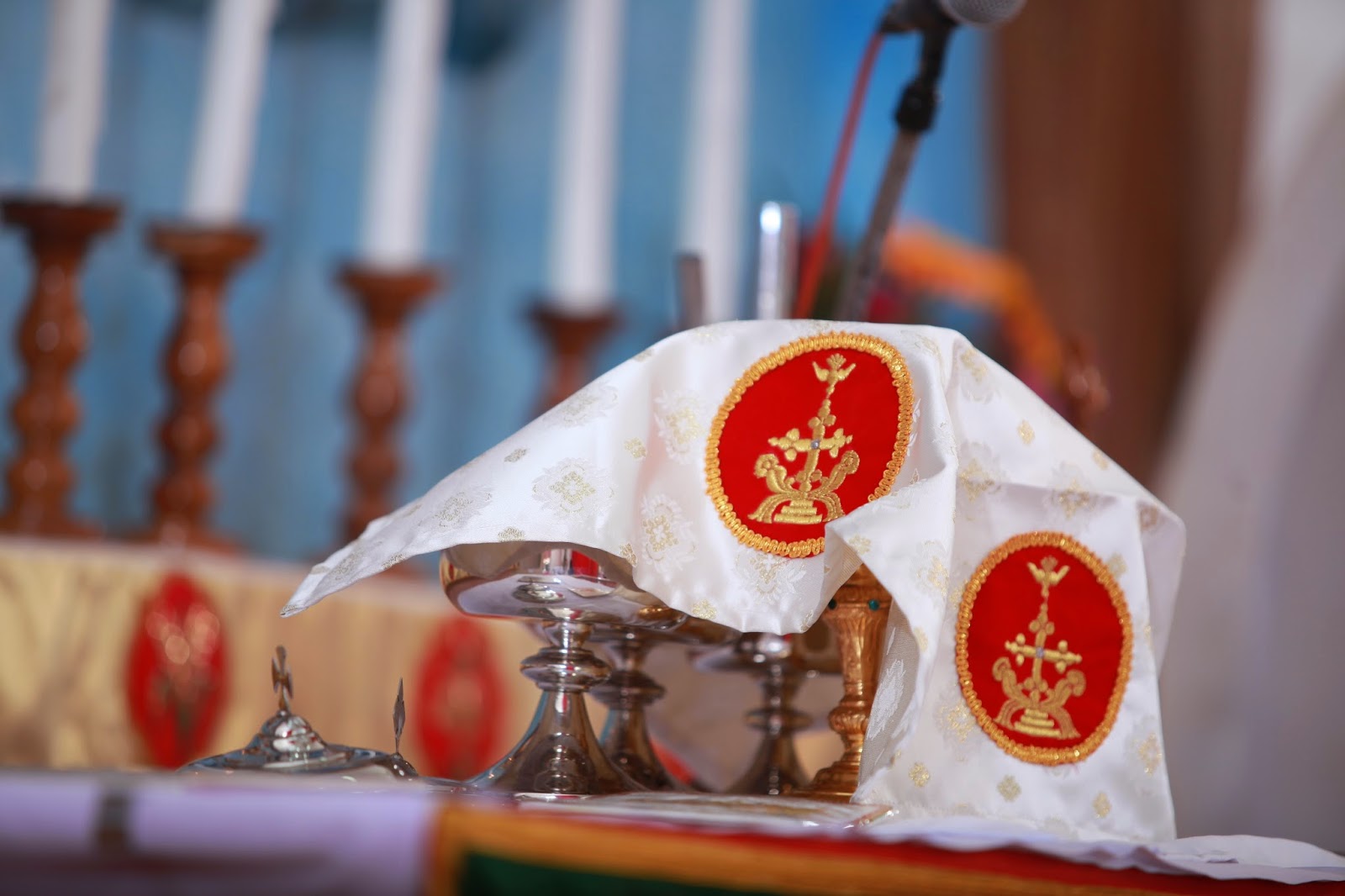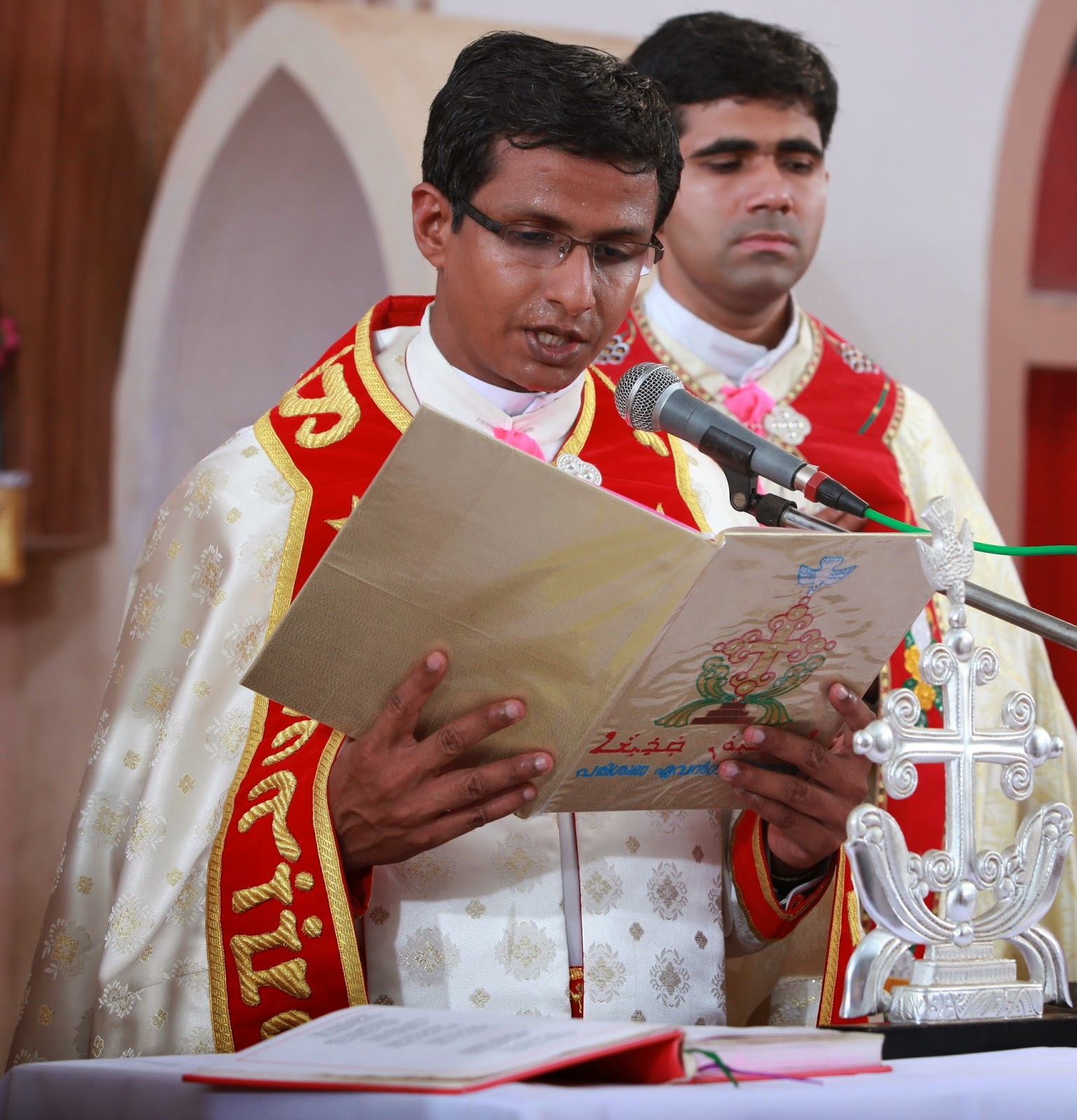Chaldeo-Indian Church
or Chapel
1. Altar.
2. Evangalion. 3 + 7. Mar
Toma Sliba 4+5 Bet Gazze. 6. Tabernacle. 8. Madbha.
9. Sanctuary lamb 10. Seats for Ministers. 11. Sanctuary Veil. 12. Qestroma. 13. Steps to Sanctuary. 14. Step to Qestroma. 15. Bema. 16. Haikla 17. Sacristy.
18. Bet-Sahde. 19.
Baptistry 20. Doors. 21. Lamps.
22. Lectern for Engarta 23.
Lectern for Qerjane 24. Veranda.
PROPER RESORTS
There are special places for special
objectives. Schools for study, Hospitals
for treatment, Library for reading books, play grounds for playing and so on.
“In order to commemorate the Holy Mysteries, it is necessary to have
places and arrangements befitting them.
It is in the church that the Mar Toma Nazranees usually celebrate the
Holy Qurbana. There are three parts for
their churches: Madbha (Sanctuary), Qestroma (Chancel) and Haikla (Nave). Qestroma is made one step higher than the
Haikla and the Madbha, three steps above the Qestroma. There is also a Bema (raised platform) in the
Haikla.”
MADBHA
Madbha
(Sanctuary) is the most elevated and important space inside the Church. It is the heaven on earth. The altar is erected in its centre nearer to
the eastern wall.
Altar:
Altar remains as tomb of our Lord, Iso’-Msiha
and as the throne of God. Iso’-Misha’s
tomb
means the empty tomb, namely, the tomb of Risen Lord. In short, the Altar is the Image of the Risen
Lord.
The Syriac word Misha means “the anointed one”.
During the consecration of an altar, the altar is completely anointed
with holy oil in order to proclaim the reality that it is the Icon or Image of Iso’-Misha
himself.
Sornos:
Aged Mar Toma Nazranees of traditional training call the altar, “SORNOS”. It is the Malayalam rendering of Tronos, the Greek word that reached them
through Syriac. Tronos in Greek and in Syriac means the “throne”. Thus altar is the throne of God in the Madbha, which is, in fact, the heaven on
earth.
In the Symbol of Faith (Creed), we proclaim that we believe “in one Lord
... ascended into heaven, and sits at
the right hand of his Father”. The very
same fact we proclaim by action when the Gospel
Lectionary (Evangalion) is enthroned solemnly on the right hand side of the
Altar.
 Evangalion:
Evangalion, i.e., the Gospel Lectionary, represents the risen
Lord. It includes only the Gospel
pericopes, proclaimed in the Liturgy and it is taken out of the Madbha only for proclaiming it in the
Liturgy or for carrying it in procession.
Whenever it is to be taken out, it is done only with the accompaniment
of lighted candles, incense and so on.
Evangalion:
Evangalion, i.e., the Gospel Lectionary, represents the risen
Lord. It includes only the Gospel
pericopes, proclaimed in the Liturgy and it is taken out of the Madbha only for proclaiming it in the
Liturgy or for carrying it in procession.
Whenever it is to be taken out, it is done only with the accompaniment
of lighted candles, incense and so on.
Mar
Toma Sliba: Mar Toma Sliba is placed
or enthroned on the left hand side of the altar. Symbolism of Mar Toma Sliba has already been described. It is also the Image of God the Holy Spirit, since the resurrection of our Lord
happened by the work of the Holy Spirit.
Hence the altar for a Mar Toma
Nazranee is the throne of God: he or she sees the Father seated in the
centre, the Son on the right and the Holy Spirit on the left. A priest who solemnly approaches the altar to
celebrate the mysteries, kisses it first in the centre, then on the right and
again on the left in order to confess the Trinitarian economy of salvation.
A Mar
Toma Sliba of bigger and
proportionate size is fixed at the centre of the eastern wall in the Sanctuary.
Bet-Gazza:
The Bet-Gazze, “Treasuries” are
arranged on both sides of the altar.
Usually they are made as niches or recesses in the eastern wall itself
or the northern and southern walls of the sanctuary. They are places for preparing the Eucharistic
gifts. The chalice is prepared in the bet-Gazza
on the southern side and paten in
that on the northern side. If properly
arranged, the bet-Gazza on the
northern side could be used to preserve the Holy Body of our Lord. But today usually a tabernacle is arranged
near the northern bet-Gazza to
preserve the Holy Eucharist.


Sanctuary
Veil: There must be an opaque veil in all churches of Mar Toma Nazranees. It
separates the Sanctuary from other parts of the church. Generally, the Sanctuary is kept veiled. It is, in fact, a proclamation of our faith
in heaven, which is beyond our ordinary human perception. It is during liturgical celebrations that we
are given an experience of heaven. Hence
the sanctuary is opened at determined times during such celebrations.
Sanctuary
Lamp: At the entrance of the sanctuary, there must be a lamp. Usually it is hung from the roof of the
sanctuary and lit always as a sign of the presence of God in the sanctuary,
which is heaven on earth.
QESTROMA
Qestroma,
“Chancel”, is the space in between the Sanctuary and the nave. It is made three steps below the sanctuary
but one step higher than the nave.
Traditionally, it is the place for the trained Choir. According to the directives given in the
recently approved Order of the Raza,
the Bema table, where the first part
of the Liturgy is conducted, could be well arranged in the Qestroma.
HAIKLA
Haikla,
the “Nave,” is the spacious place for the community at the western portion of
the church. Symbolically it is the
earth, the place for the lower or earthly choir in the Liturgy.
Bema:
Bema, the “Dais”, is a raised
platform in the middle of the nave.
There must also be a table on it.
The table is the symbol of Calvary and the platform (Bema), itself of earthly Jerusalem. There must be a Mar Toma Sliba on this
table and candles or lamps on either side of it. Candles or lamps symbolize the Old and New
Testaments.
On either side of the table on the Bema lecterns are arranged for Old
Testament readings (Qeryana) and the
Epistle (Enggarta). The Epistle is read from the lectern on the
north and the Old Testament readings from that on the south.
“The church, for Mar
Toma Nazranees, is the symbol of the whole universe. As heaven and earth, and everything related
to them, are also related to the Mystery of redemption, the divine Liturgy,
which is its commemoration in signs and symbols, must also be celebrated
against that background. Liturgy is a
celebration where the heavenly and earthly choirs mingle together. The design of the churches in Mar Toma Margam
ought to be seen in this light.”
BAPTISTRY
Baptistry is built close to the
Sanctuary on its south side. The
baptismal font and everything needed
for the celebration of Baptism are
arranged in this particular space.
Baptistry must be accessible also from the Sanctuary. Rites exclusive for Baptism are conducted in
the Baptistry.
SACRISTY
Sacristy
is the place where the priests and other ministers vest themselves for
liturgical rites. Usually it is built on
the northern side of the sanctuary, having possibility of direct entrance to
it.
BET-SAHDE
Bet-Sahde
is a convenient place or room, usually adjacent to the Sacristy, where the
relics of the saints are venerated. It
was in fact the burial place for saintly priests and bishops. The people began to come together there and
seek their help and mediation. Slowly
the community began to deposit there the relics they got from other
Churches. Thus it became a place of
saints’ veneration. In the present day
context, the cemetery chapel itself could be very well so arranged. The Mar
Toma Nazranees would better
express their respect and veneration to saints and martyrs relating it to this
special place and not associating it to the church itself as it is in the Latin
tradition.
 There are several prayers, hymns and
liturgical actions involved in the Spiritual
Preparation. Prostration in the Raza is an expression of unworthiness to
celebrate the Mysteries. Washing of
hands symbolizes internal purification.
Solemn approach with special prayers and actions after professing the
faith is another act of spiritual preparation.
The exchange of peace and
everything connected with it also stress the internal silence and recollection necessary
for a worthy celebration.
There are several prayers, hymns and
liturgical actions involved in the Spiritual
Preparation. Prostration in the Raza is an expression of unworthiness to
celebrate the Mysteries. Washing of
hands symbolizes internal purification.
Solemn approach with special prayers and actions after professing the
faith is another act of spiritual preparation.
The exchange of peace and
everything connected with it also stress the internal silence and recollection necessary
for a worthy celebration.


























